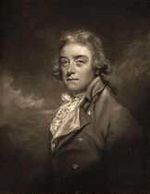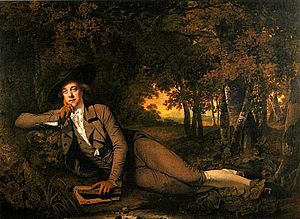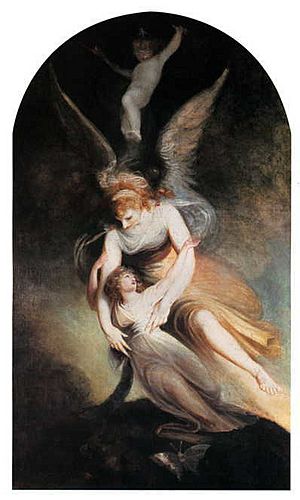Sir Brooke Boothby, 6th Baronet facts for kids
Quick facts for kids
Sir Brooke Boothby
|
|
|---|---|

Print by John Raphael Smith after Reynolds
|
|
| Born | 3 June 1744 Ashbourne, Derbyshire, England, Great Britain
|
| Died | 23 January 1824 Boulogne, Paris, France
|
| Burial place | St. Oswald's, Ashbourne, Derbyshire, England |
| Education | St John's College, Cambridge |
| Occupation | Translator, poet, landowner |
| Title | 6th Baronet Boothby, of Broadlow Ash |
| Spouse(s) | Susanna Bristoe |
| Children | Penelope |
| Parent(s) | Sir Brooke Boothby, 5th Bt. Phoebe Hollins |
Sir Brooke Boothby, 6th Baronet (born June 3, 1744 – died January 23, 1824) was an English writer, translator, and landowner from Derbyshire. He was known for his love of books and his friendships with important thinkers of his time.
One of his most famous friends was the French philosopher Jean-Jacques Rousseau. In 1766, Boothby welcomed Rousseau to his home in Ashbourne. Later, in 1776, Boothby visited Rousseau in Paris. Rousseau gave him the first part of his autobiography, Confessions. Boothby translated this book and published it in England in 1780, after Rousseau had passed away. He later gave the original manuscript to the British Library.
A famous painting of Boothby by Joseph Wright of Derby from 1781 shows him relaxing with a book. The book simply says "Rousseau" on its cover. This shows how much Boothby admired Rousseau and wanted to share his ideas with others. Boothby also had a daughter named Penelope, who sadly died very young. Her father wrote a book of poems to remember her.
Contents
Life and Times of Sir Brooke Boothby

Sir Brooke Boothby was born in 1744. He got his unique first name from Hill Brooke, who was married to an earlier Baronet Boothby. He went to St John's College, Cambridge to study in 1761.
Boothby's Connections and Interests
Boothby was very involved in the intellectual life of his area. He was friends with members of the Lunar Society. This group was interested in how science could improve daily life. He also joined the Lichfield Botanical Society, showing his interest in plants.
In 1766, Boothby met the famous French thinker Jean-Jacques Rousseau. Rousseau had left France and was staying near Boothby's home, Ashbourne Hall. They became good friends.
Translating Rousseau's Confessions
Boothby later visited Rousseau in Paris. He promised Rousseau that he would publish his autobiography, Confessions. Boothby published the book in French in Lichfield.
The painting by Joseph Wright of Derby shows Boothby in a peaceful, wooded area. This place was known as the Twenty Oaks. Boothby and Rousseau often met there to talk. Rousseau also went there to write in peace. In the painting, Boothby holds a book with "Rousseau" on its spine. This shows his deep interest in all of Rousseau's writings. The natural setting in the painting also hints at Rousseau's idea that people are happiest when they are close to nature. Boothby was also interested in botany, the study of plants. Rousseau also studied local plants when he lived nearby.
Boothby bought other paintings from Joseph Wright of Derby, including two views of Dovedale. He also bought two paintings of bridges in Rome.
Family Life and Sadness


In 1784, Boothby married Susanna Bristoe. That same year, he started renting Ashbourne Hall from his father. His father had spent a lot of money, so he had to live elsewhere. Boothby began to fix up Ashbourne Hall. He used his wife's money to renovate the house, improve the gardens, and buy rare plants and art.
His only daughter, Penelope, was born in April of the next year. Sir Joshua Reynolds painted a famous portrait of Penelope when she was young. It is often called "The Mob Cap" and is one of the most well-known paintings of children in England.
Sadly, on March 19, 1791, Penelope died at the age of five. This was a very difficult time for Boothby. He later published a book of poems called Sorrows Sacred to the Memory of Penelope. A special tomb was built for Penelope in St Oswald's Church, Ashbourne. It has a life-size statue of her sleeping. Many other Boothby family members are also buried there.
After Penelope's death, Boothby's life became more difficult. He ordered the sculpture of Penelope and a painting by Henry Fuseli. His wife, Susanna, moved back to her parents' home.
Later Years and Legacy
In 1801, Boothby helped Lichfield Cathedral buy beautiful stained glass from a dissolved abbey. He sold the glass to the cathedral without making any profit.
Boothby faced financial problems later in life. In 1814, Ashbourne Hall was leased to someone else. He moved to Boulogne, France, in 1815 and passed away there in 1824. He was buried in St. Oswald's Church in Ashbourne with his family.
A Poem for Penelope
Boothby wrote many poems, including this one for his daughter, Penelope. It shows his deep sadness and love for her.
Well has thy classick chisel, Banks, express'd
The graceful lineaments of that fine form,
Which late with conscious, living beauty warm,
Now here beneath does in dread silence rest.
And, oh, while life shall agitate my breast,
Recorded there exists her every charm,
In vivid colours, safe from change or harm,
Till my last sigh unalter'd love attest.
That form, as fair as ever fancy drew,
The marble cold, inanimate, retains;
But of the radiant smile that round her threw
Joys, that beguiled my soul of mortal pains,
And each divine expression's varying hue,
A little senseless dust alone remains
Major Works by Sir Brooke Boothby
Sir Brooke Boothby wrote and translated several important works:
- Letter to the Right Honourable Edmund Burke, 1790
- Observations on the Appeal from the New to the Old Whigs, 1792
- Sorrows. Sacred to the Memory of Penelope, 1796 (a book of poems for his daughter)
- Venality, 1793 and 1802
- Translation of Jean Racine's play Britannicus, 1803
- Fables and Satires, 1809
- Translation of Molière's play Le Misanthrope, 1819
- The Fudger Fudged, 1819
See also
- The Nightmare by Henry Fuseli, a painting bought by Boothby.


